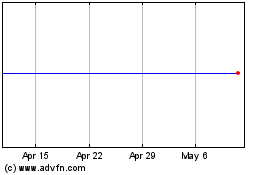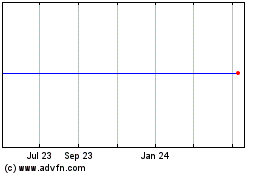Data Presented Today at the American Academy of Ophthalmology 2016 Annual Meeting Reinforce Efficacy and Durability of Voreti...
October 14 2016 - 1:15PM

Spark Therapeutics (NASDAQ:ONCE), a fully integrated gene therapy
company seeking to transform the lives of patients with
debilitating genetic diseases by developing investigational,
potentially one-time, life-altering treatments, announced today
that Principal Investigator Albert M. Maguire, M.D., professor of
ophthalmology at the Perelman School of Medicine of the University
of Pennsylvania, presented one-year efficacy data from the
crossover group and two-year durability data from the original
intervention group for the Phase 3 trial of voretigene neparvovec
(formerly SPK-RPE65) during Retina Subspecialty Day at the American
Academy of Ophthalmology 2016 Annual Meeting in Chicago.
Voretigene neparvovec, an investigational gene therapy for
Inherited Retinal Disease (IRD) caused by mutations in the RPE65
gene, has received both breakthrough therapy and orphan product
designations from the U.S. Food and Drug Administration (FDA), as
well as orphan product designations from the European Medicines
Agency (EMA).
The crossover group consists of nine subjects who, after one
year of undergoing the same retinal and visual function testing as
the original intervention group, elected to cross over and receive
voretigene neparvovec in both eyes. One year after administration,
the mean improvement among all nine subjects, as measured by the
primary endpoint, a multi-luminance mobility test (MLMT), was 2.1
lux levels.
Dr. Maguire also presented data that showed that the original
intervention group subjects who received voretigene neparvovec
(n=20) maintained improvement demonstrated at year one, as measured
in MLMT and full-field light sensitivity threshold (FST) testing,
for at least two years. The mean MLMT improvement of 1.9 lux levels
was sustained after two years. The more than 100-fold average
improvement in FST testing observed in the original intervention
group at one year similarly was maintained through at least two
years.
“Results from the ongoing Phase 3 trial of voretigene neparvovec
show that 93% of subjects, including those in the original control
group who crossed over to receive intervention, demonstrated a gain
in functional vision, and maintained that improvement over one year
following the procedure,” said Dr. Maguire. “Additionally, the
original intervention group sustained its year one improvement at
year two. These data further bolster the growing dataset supporting
voretigene neparvovec.”
Visual Field Data Show Statistical Significance Across
Two Measures For the first time, Dr. Maguire presented
data on visual field (VF), another protocol-specified endpoint in
the Phase 3 trial of voretigene neparvovec. VF is total field area
of a person’s retinal sensitivity, or vision, that extends from a
central fixation point to the periphery. Data collected using two
VF measures showed statistically significant responses.
“Using the Goldmann III4e test stimulus, the visual field area
of the original intervention group showed significant improvement,
nearly doubling at year one, while a slight decrease in visual
field area was observed in the control group,” said Dr.
Maguire.
Using the Goldmann III4e test stimulus, the intervention group
saw a mean increase of 302.1 sum total degrees from baseline at
year one, while the control group saw a mean decrease of 76.7 sum
total degrees, resulting in a difference of 387.7 sum total degrees
(nominal p=0.006). Additionally, using the Humphrey macula
threshold measure, the visual field increased by a mean of 7.7
decibels (dB) from baseline for the intervention group, compared to
a decrease of 0.2 dB for the control group, resulting in a
difference of 7.9 dB (nominal p<0.001).
“The visual field data clearly demonstrate the effect of the
investigational therapy on a well-understood clinical endpoint and
we will be further examining these data over the next few months,”
said Katherine A. High, M.D., president and chief scientific
officer, Spark Therapeutics.
Voretigene Neparvovec Phase 3 Trial OverviewThe
Phase 3 trial for voretigene neparvovec includes an original
intervention group of 20 subjects who had voretigene neparvovec
administered in both eyes and a control group of nine subjects. All
nine control subjects elected to “cross over” and have voretigene
neparvovec administered following one year of the same retinal and
visual function testing of the original intervention group. The
mITT population (n = 29) includes all subjects who received
voretigene neparvovec, either in the original intervention group or
in the crossover group of the Phase 3 trial.
Findings from the original intervention group announced in the
fall of 2015 include statistically and clinically significant
improvement compared to the control group on the primary endpoint,
measured in change in MLMT between baseline and one year. The first
two secondary endpoints – FST for white light and MLMT for the
assigned first eye – also showed highly statistically significant
improvement. A third secondary endpoint, visual acuity, did not
meet statistical significance.
Safety results in the voretigene neparvovec clinical program
have been consistent to date. No serious adverse events (SAEs)
associated with voretigene neparvovec or deleterious immune
responses have been observed. There was one SAE in one eye of a
Phase 3 crossover group subject, which was determined to be related
to the surgical procedure, rather than to the product candidate.
The subject exhibited foveal thinning and a reduction in visual
acuity after the surgical procedure that did not return to baseline
but did show an improvement on the MLMT and also exhibited a gain
in FST. An additional SAE related to participation in the clinical
studies occurred in one eye of a Phase 1 follow-on study subject;
in this case, the treatment for bacterial endophthalmitis led to
elevated intraocular pressure and subsequent optic atrophy.
About Spark TherapeuticsSpark Therapeutics, a
fully integrated gene therapy company, is seeking to transform the
lives of patients with debilitating genetic diseases by developing
investigational, potentially one-time, life-altering treatments.
Spark Therapeutics’ validated gene therapy platform is being
applied to a range of clinical and preclinical programs addressing
serious genetic diseases, including inherited retinal diseases,
liver-mediated diseases such as hemophilia, and neurodegenerative
diseases. Spark Therapeutics’ validated platform successfully
has delivered proof-of-concept data with investigational gene
therapies in the retina and liver. Spark Therapeutics has reported
top-line results from a pivotal Phase 3 clinical trial for its most
advanced product candidate, voretigene neparvovec (formerly
referred to as SPK-RPE65), a potential treatment of a rare genetic
blinding condition. Voretigene neparvovec has received both
breakthrough therapy and orphan product designations. Spark
Therapeutics’ hemophilia franchise has two lead
assets: SPK-9001 in a Phase 1/2 trial for hemophilia B
being developed under a collaboration with Pfizer and SPK-8011, a
preclinical candidate for hemophilia A to which Spark Therapeutics
retains global commercialization rights. To learn more, please
visit www.sparktx.com.
Spark Therapeutics Corporate Contacts
Stephen W. Webster, Chief Financial Officer
Daniel Faga, Chief Business Officer
(855) SPARKTX (1-855-772-7589)
Media Contact
Dan Quinn
Ten Bridge Communications
(781) 475-7974
dan@tenbridgecommunications.com
Onconetix (NASDAQ:ONCE)
Historical Stock Chart
From Mar 2024 to Apr 2024

Onconetix (NASDAQ:ONCE)
Historical Stock Chart
From Apr 2023 to Apr 2024
